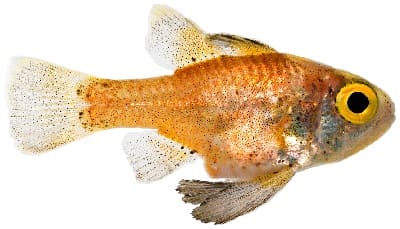Home › Sea Life › Marine › Vertebrates › Cardinal Fishes › Conch Fish
Fun Facts about Astrapogon Stellatus
[Phylum: Chordata] [Class: Actinopterygii] [Order: Kurtiformes] [Family: Apogonidae (ray-finned)]
The symbiotic relationship between A. stellatus (the conchfish) and a species of large sea snails (the queen conch) is under threat, mostly due to overfishing.
This guide contains facts and information about Astrapogon stellatus cardinal fish and why alternative refuges with Atrina rigida (the rigid pen shell) could be key for their survival.
Astrapogon Stellatus Conchfish Distribution
You will find many of the Apogonidae family (cardinalfishes) inhabiting coastal regions of the Atlantic and Indian oceans.
But, A. stellatus is more native to the warmer waters of the Caribbean Sea, the western Atlantic Ocean, and selected areas in:
- Bermuda, the Bahamas, Florida
- Greater and Lesser Antilles
- Rio de Janeiro (south Brazil)
- The ocean basin of the Gulf of Mexico
Pro Tip: Another species of ray-finned fish, the Cardinalfish (Apogon Imberbis) are commonly found in the eastern Atlantic and many regions of the Mediterranean Sea.
Characteristics of Conchfish Cardinal Fish
Like most cardinal fish species, the Astrapogon stellatus has large eyes. This provides them with efficient vision for the dark environments that they inhabit.
Several other characteristics help to distinguish the conchfish from many others in the Apogonidae family, such as:
- Brown or black colouring
- Large oblique (sloping) mouth
- Oblong body shape
- Strong caudal peduncle (used for swimming)
- Two dorsal fins (widely separated)
- Large, smooth body scales
After full maturity, the adult A. stellatus will grow up to eight (8) centimetres in length (around 3 inches). Which, when compared with the King of the Mullets cardinal fish, is quite small.
Some specimens display a shimmery pale phase. This pigmentation, and other meristic variations, help to isolate them from some of their close relatives.
In general, the most likely place to find Astrapogon stellatus is in the mantle cavity of the queen conch. But, you can also find them around shallow reefs, tube sponges, and seagrass beds. It would be unusual for a conch fish to swim deeper than forty (40) metres (130 feet).
What Does Astrapogon Stellatus Eat?
Having big eyes means this species is content with spending a lot of the daytime hours in dark ravines. It becomes a lot more active in deeper water at night when it hunts for food.
 The nocturnal cardinal fish species prefers plankton found in open sea.
The nocturnal cardinal fish species prefers plankton found in open sea.
But some of the Apogonidae genus have been know to eat:
- Aquatic crustaceans (e.g. Artemia, brine shrimp)
- Euphausiacea (krill)
- Marine invertebrates
- Opossum shrimps
- Zooplankton (e.g. microscopic organisms)
Pro Tip: Another section contains a comprehensive list of vertebrate and invertebrate animals with lots of fun and interesting facts, pictures, and videos.
Astrapogon Stellatus and Conchs
A symbiotic relationship exists beteen A. stellatus and Aliger gigas (the queen conch). The mantle cavities of these marine mollusks provide a safe home during the daylight. Then, the fish emerges after darkness falls to forage for food.
Threats and Predators
In fact, overfishing is threatening the queen conch population. As a result, recent reports suggest the conch fish is using alternatives, such as the rigid pen shell (Atrina rigida) and the amber pen shell (Pinna carnea).
Nonetheless, the threat status for the Mediterranean cardinalfish species in Europe is of 'Least Concern' - according to information on the IUCN website.
Fun Facts about Cardinal Fish
- The male cardinalfish has the responsibility of keeping the eggs inside its mouth until they hatch. So, until the male expels the eggs, usually eight (8) days later, it does not eat any food.
- Incubating eggs inside the mouth has the advantage of protecting them against natural predators, such as the horn shark (Heterodontus francisci), during the initial phase of their development.
- Nonetheless, because males often repeat this process three or four times per year, they often die of starvation.
Related Information and Help Guides
- Best Dive Sites to See Mediterranean Cardinalfish Species
- Mediterranean Cardinalfish Facts and Information with Pictures
- Flashlight Fish Facts and Species Information with Pictures
- List of Marine Vertebrates Examples for Beginners
- Wrasses Facts and Species Information with Video
Note: The short video contains footage of the Apogon imberbis (Cardinal fish) swimming and feeding in a natural dusky habitat.